Does Rice Paper Cake Sheet Have a Backing to Remove
How to cook rice in a pot on the stove (my default),microwave oroven! My method to make steamed rice is simple and foolproof – no rinsing, no colanders, or any of the other fussy techniques called for in other recipes. Your rice will be fluffy and tender every single time – never gluggy or mushy. And I'm a rice snob!
Use this recipe for: short, medium and long grain white rice. See separate directions for: jasmine, basmati and brown rice.
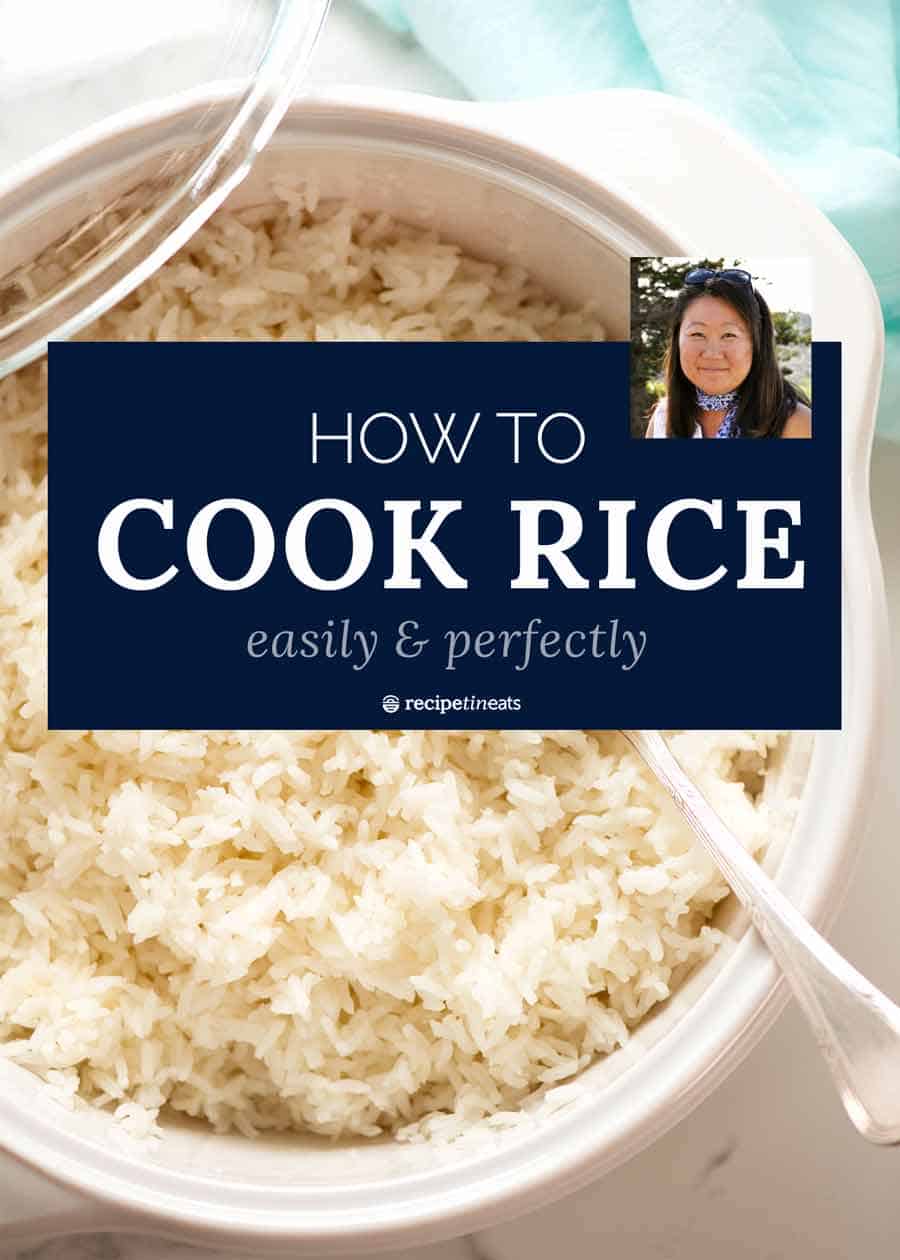
JUMP TO VIDEO | RECIPE | Stove | Oven | Microwave |
Rice Types | Biggest Mistakes | No rinsing! | Troubleshooting | Useful Info
How to cook rice
Everyone should know how to cook rice perfectly – without a rice cooker! So today, I'm sharing how I cook rice, 3 different ways:
-
Stove in a pot (13 min) –the best results, the way I usually make rice;
-
Oven (35 min) – the most hands off way, and the easiest way to cook rice in big batches;
-
Microwave (12 min) –the fastest, hands off way
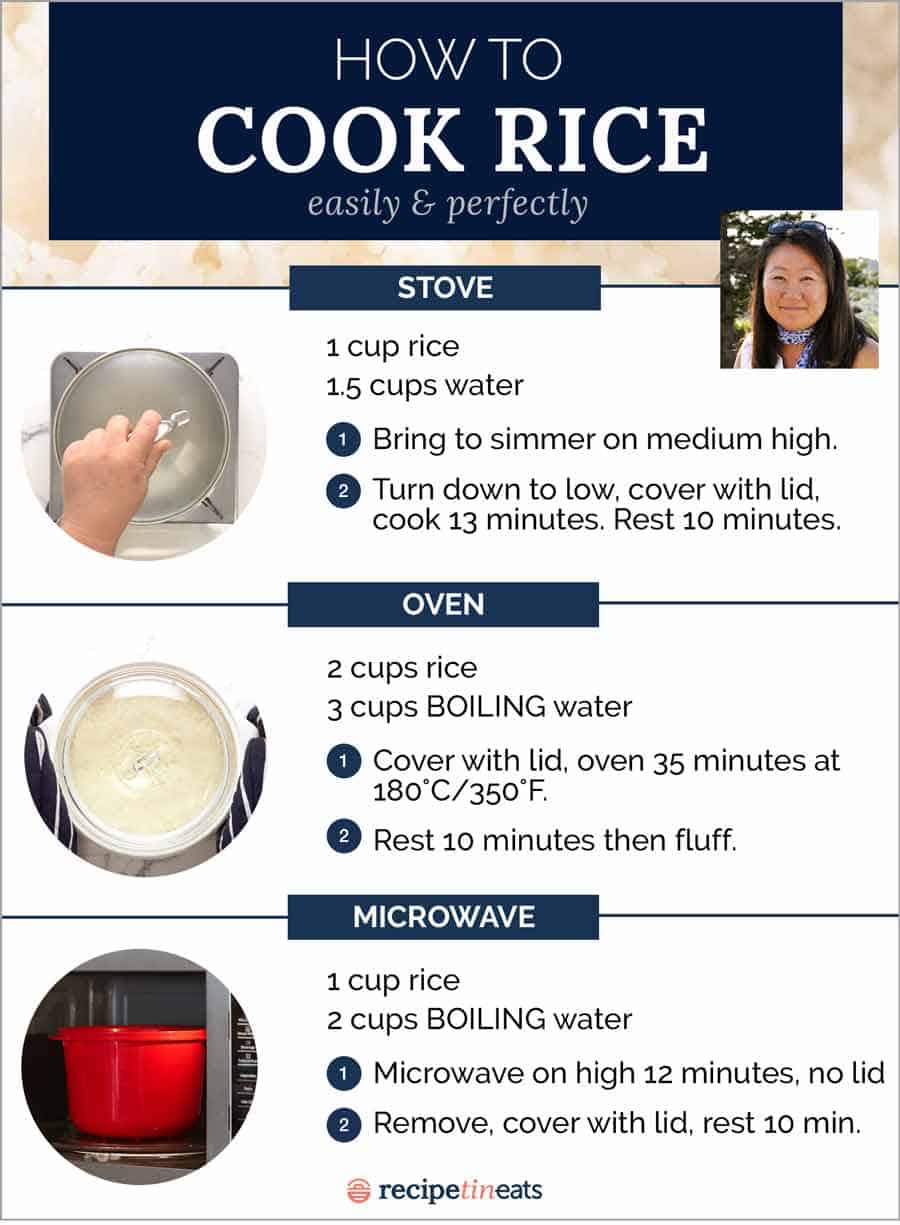
Which rice to use for this recipe
Use this rice recipe for:
-
long grain white rice
-
medium grain white rice
-
short grain white riceexcept sushi rice (which is a type of short grain rice, see below)
See separate recipes for:
-
basmati rice
-
jasmine rice
-
brown rice
DO NOT use this recipe for:
-
sushi rice – use the directions in this recipe
-
wild rice (cook per this recipe), black rice, or other special rices
-
risotto rice – use a risotto recipe
-
paella rice – use this Paella recipe
-
quinoa – follow this recipe
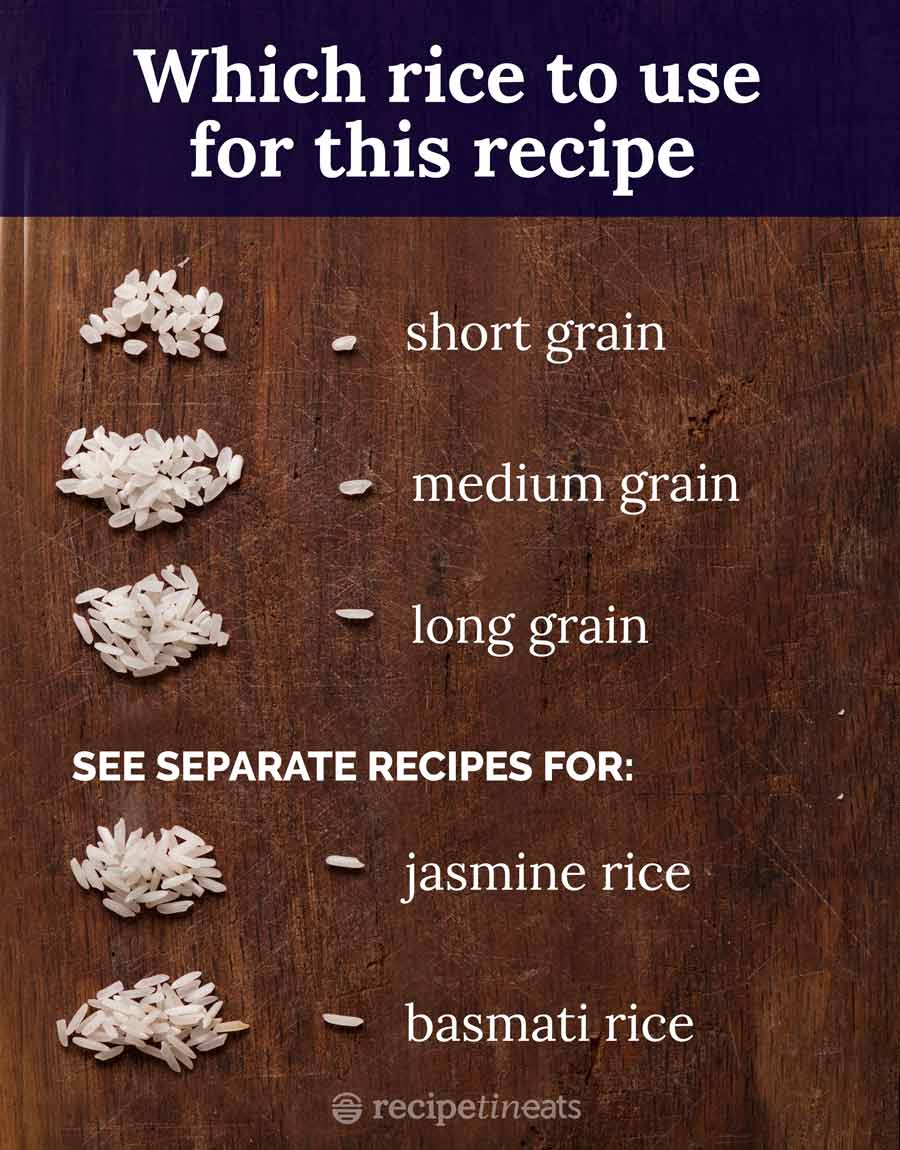
Wondering about the difference between rice types?
The general rule is that the shorter the rice grain, the stickier the rice.Sticky doesn't meany gummy! It just means the grains stick together more, rather than being crumbly, so they are easier to eat with chopsticks.
The longer the grain, the less sticky it is. Basmati is the least sticky rice (Indian food isn't eaten with chopsticks!), short grain is the most sticky. (eg. Sushi rice is a type of short grain rice, and it has to be sticky in order for sushi rolls to stay together. You can't make sushi rolls with basmati rice!)
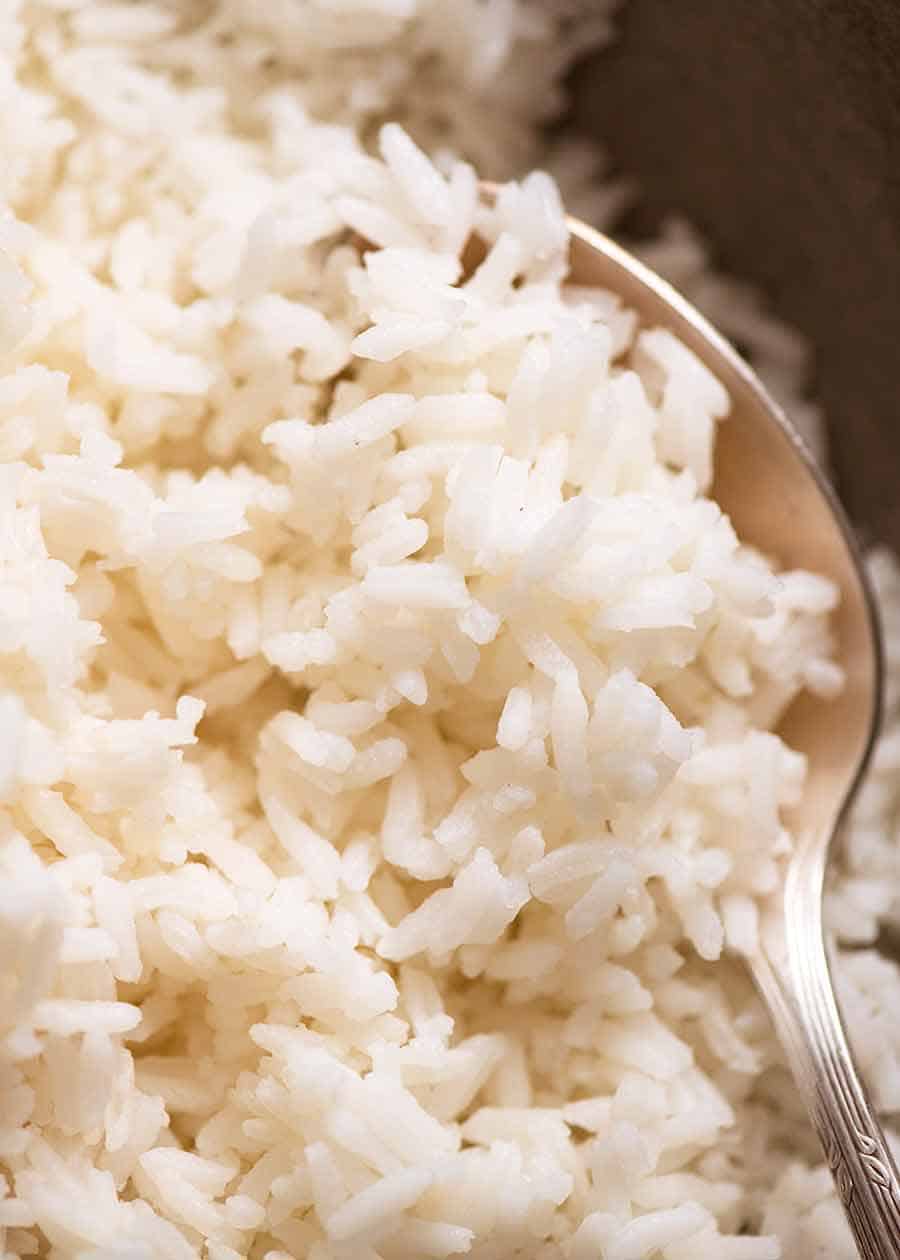
Rice to water ratio
For 1 cup of rice, you will need 1.5 cups of water for to cook rice on the stove or in the oven.
The water needs to be increased to 2 cups to cook rice in microwave.
If you rinse the rice*,reduce the water by 2 tablespoonsper cup of rice.
* You don't need to rinse rice to have fluffy rice if you use the right cooking method and rice to water ratio! More on the to-rinse-or-not-to-rinse debate below.
JUMP TO Video | Recipe
How to cook rice on the stove (my default method)
-
Place 1 cup of rice (no rinsing!) and 1.5 cups water in a saucepan and bring to a boil over medium high – no lid;
-
Turn heat down to low, cover with lid, and leave for 13 minutes;
-
With lid still on, remove saucepan from stove and stand for 10 minutes; and
-
Fluff with a rice paddle, rubber spatula or fork, marvel at perfectfluffy rice! {See recipe video for a good close up!}

JUMP TO Video | Recipe
This is my default way of cooking rice, and of the 3 methods I'm sharing today, it yields the best result – the closest to using a rice cooker. All the rice cooks evenly, the grains are tender but not mushy, and the surface of the grains are not mushy and gummy.
There is no need to rinse rice if you use my rice cooking method!
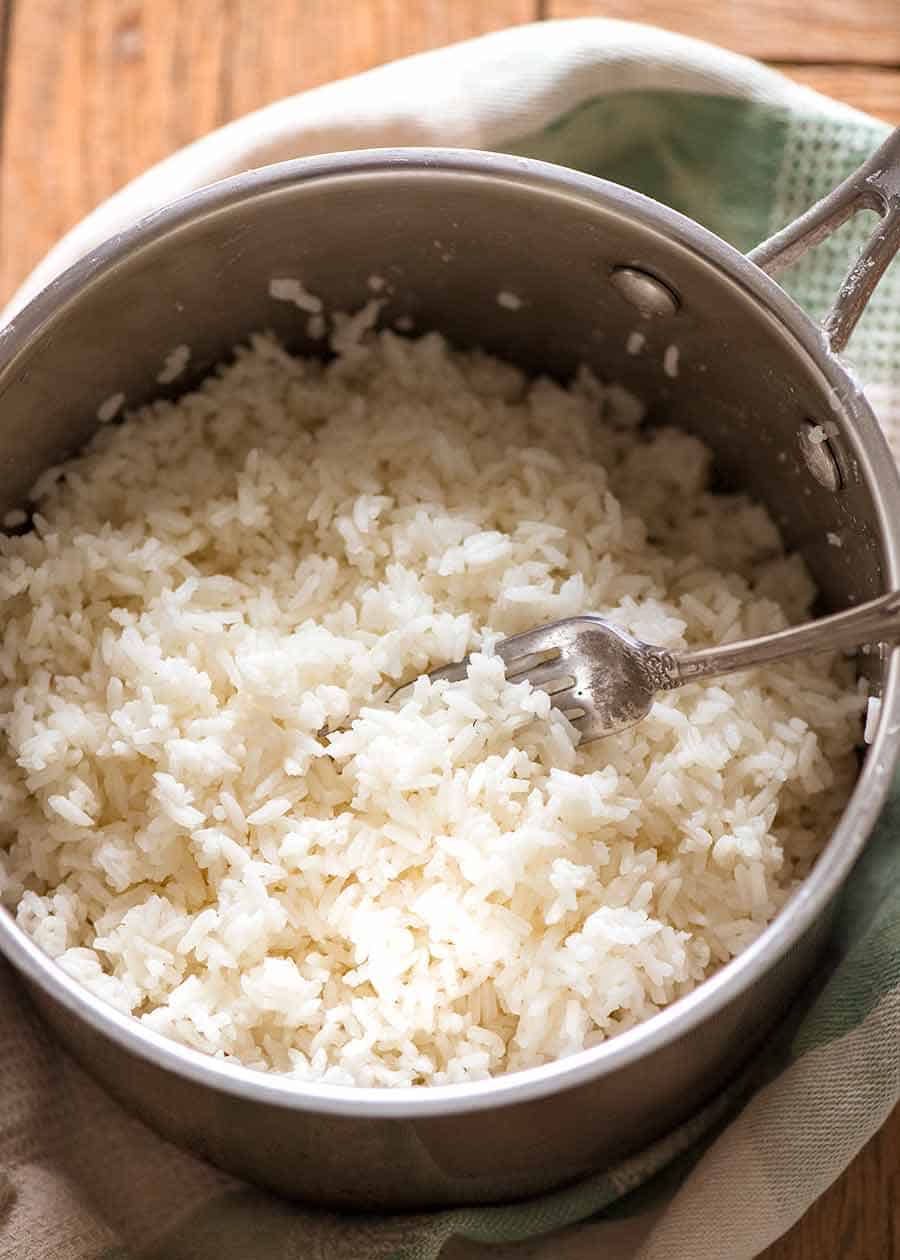
JUMP TO Video | Recipe
How to cook rice in the oven
Useful for hands off, big batch rice cooking.
-
Place rice and boiling water* in a small casserole with a lid (or use a pan and foil);
-
Cover with lid, bake at 200°C/390°F (180°C fan) for 35 minutes;
-
Remove from oven and stand for 10 minutes; and
-
Fluff with fork, marvel at perfectly cooked fluffy oven baked rice. {See recipe video for a good close up!}
* Boiling water helps rice cook more evenly in the oven because the water doesn't require time to come up to temperature in the oven (which can take over 10 minutes).
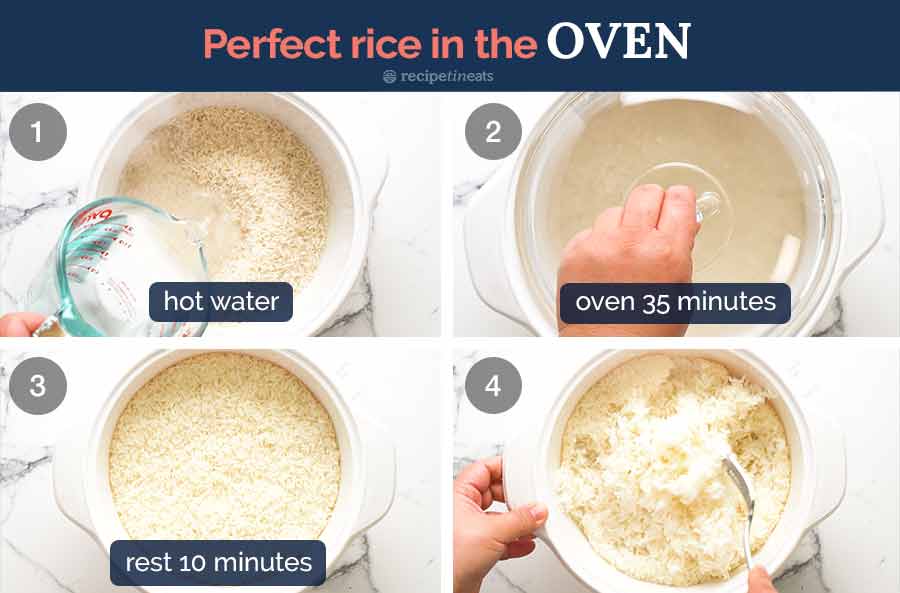
JUMP TO Video | Recipe
This is my next preferred method to cook rice. It's not as perfect as rice cooked on the stove because some of the rice on the edges gets a wee bit crispy. But it is stillvery very good and the small compromise is worth the convince of thisentirely hands-off method of cooking rice.
Some people think rice should not be sticky at ALL, but that's not right! Rice is supposed to be a bit sticky, otherwise 5 billion Asians would struggle to eat rice with chopsticks!
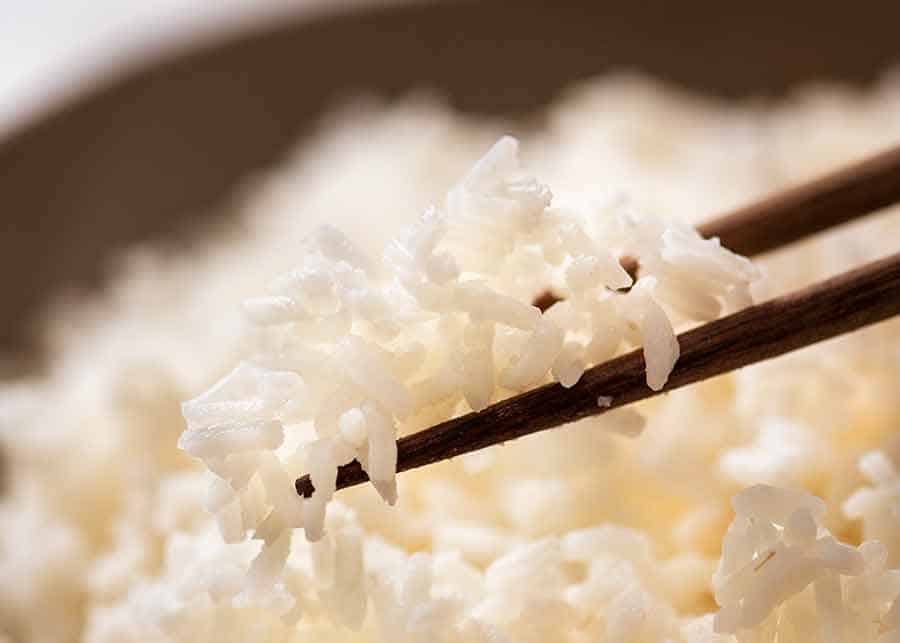
JUMP TO Video | Recipe
How to cook rice in the microwave
Useful emergency method! I use this when I'm scrambling for rice props in photos!
-
Place 1 cup of rice and 2 cups ofboiling water in amicrowave proof round^ containerthat's 3 to 4 timestallerthan the water level (the water bubbles up quite a lot);
-
Microwaveuncovered for 12 minutes on high;
-
Remove from microwave,cover then rest for 10 minutes;
-
Fluff and enjoy!
* Most microwaves heat things from the outside in. Using boiling water helps rice cook more evenly.
^ Round container cooks more evenly than square or rectangle, but not critical.
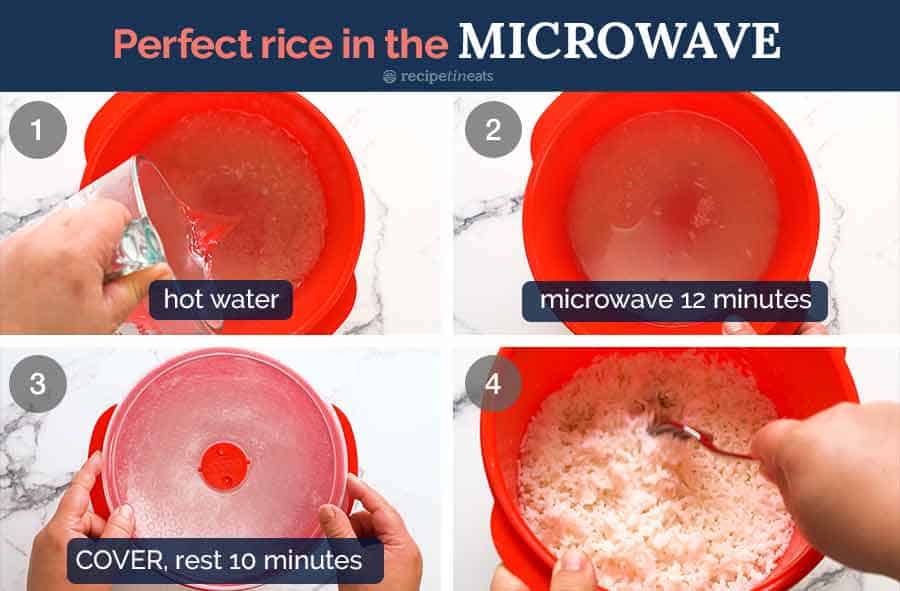
JUMP TO Video | Recipe
Cooking rice in the microwave is just as fast as using the stove, but it's more hands off. BUT microwave rice is not quite as good as cooking rice on the stove. The rice doesn't cook quite as evenly, but the difference is marginal and I'm pretty sure only rice snobs can tell the difference!
You might turn your nose up at the thought of microwave rice… but it's super handy to know how!
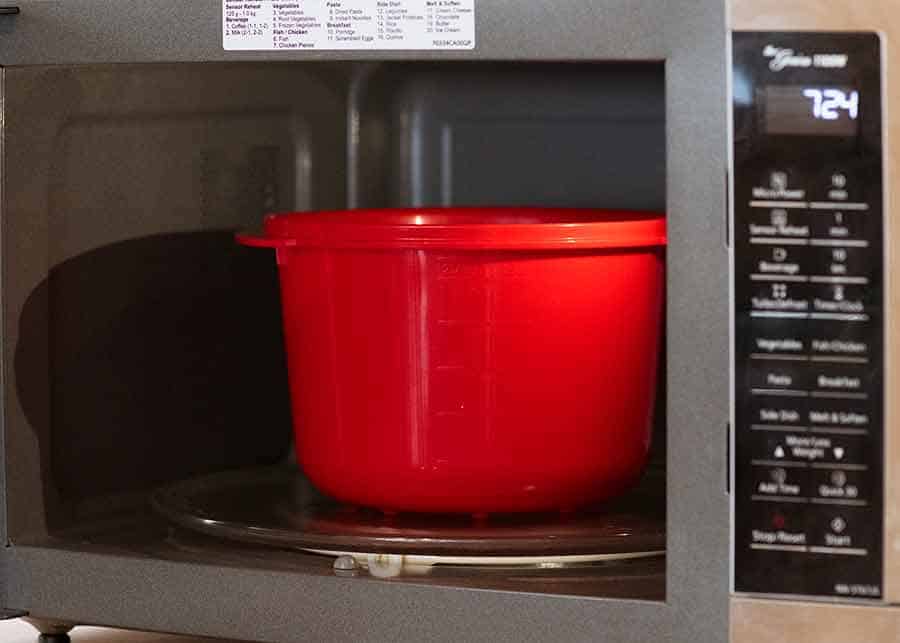
When I'm cooking on the job and need rice for stir fries or curries or something else I'm shooting, rice gets made in the microwave more often than not – for sheer convenience. Things get pretty hectic around here on shoot days!
Here's a look at the rice cooked in the microwave. Hard to capture the texture in photos, but itis fluffy and doesn't have that unpleasant gluey surface on the grains. You can see it better in the recipe video below!
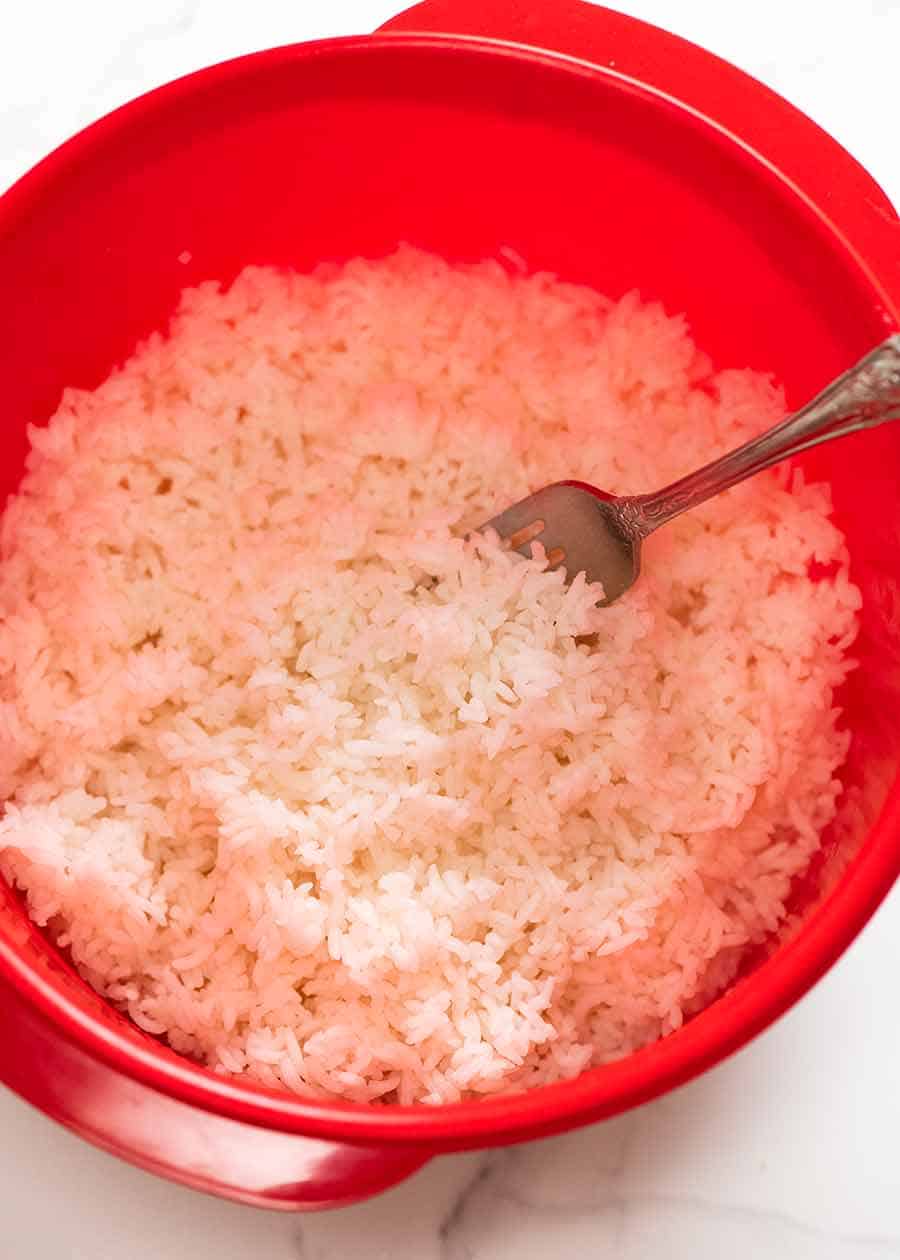
JUMP TO Video | Recipe
The biggest mistake you've been making all your life
The biggest mistake people make when cooking rice is usingtoo much waterwith most recipes calling for 2 cups of water to 1 cup of rice for stovetop cooking. This virtually guarantees overly soft rice with gummy surfaces.
The problem of too much water is then exacerbated by rinsing the rice, with promises that removing the excess starch will make your rice fluffy. Ever weighed your rice before and after rinsing? All that extra weight = water.
So actually, recipes that call for 2 cups of water AND rinsing rice end up using almost 2 1/4 cups of water for 1 cup of rice = overly soft rice with gummy surfaces.
The perfect rice to water ratio is 1:1.5 for the stove. If you insist on rinsing the rice, reduce the water by 2 tablespoons.
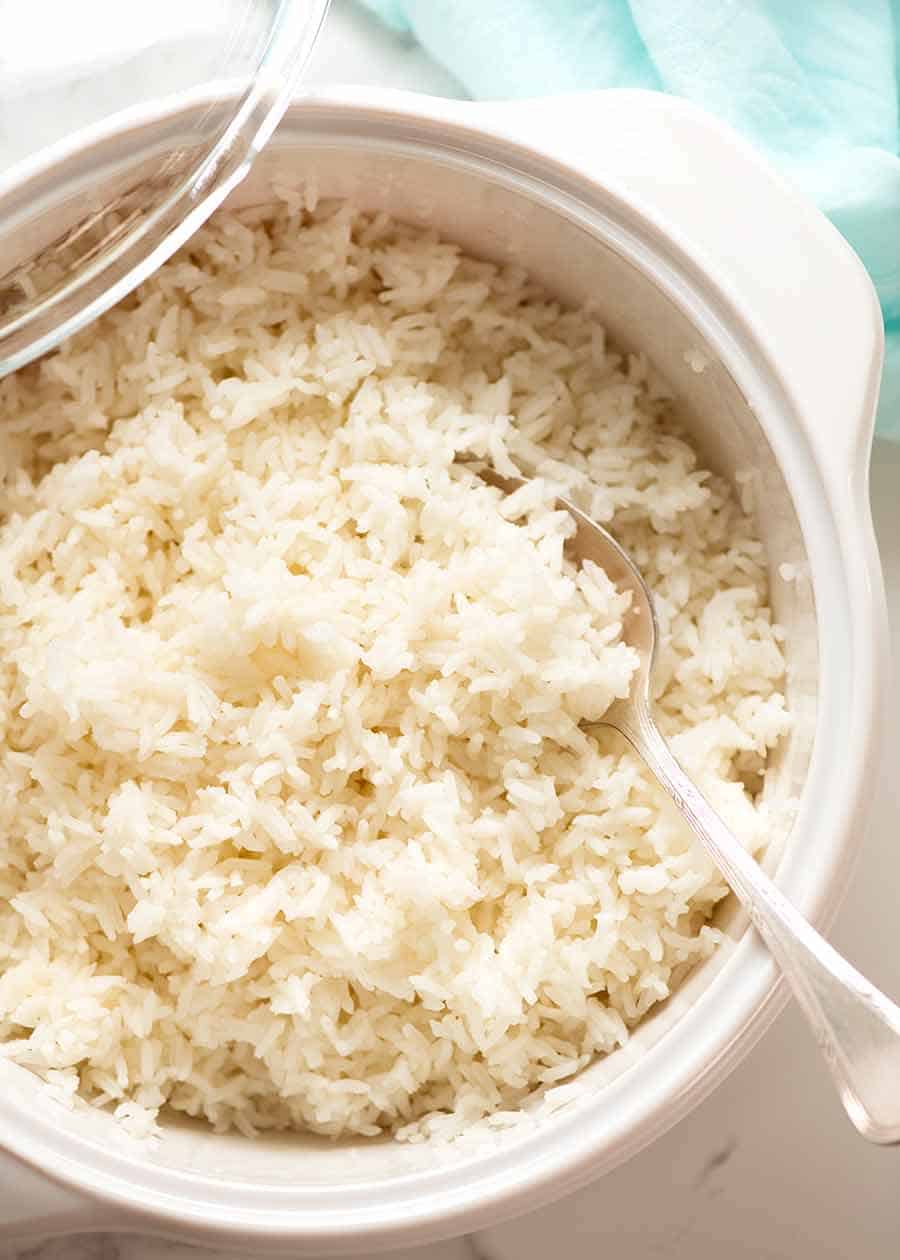
JUMP TO Video | Recipe
There is no need to rinse rice to make it fluffy!
There's a widely held belief that rinsing rice is the key to to successful rice, that doing this washes away excess starch on the rice grains which makes the rice extra fluffy.
Yes that's true, it does wash away excess starch.
But your rice will still be beautifully fluffy even without rinsing if you use my 1:1.5 rice to water ratio and cooking method for the stove (or other methods above).
The only reason to rinse rice are under the following circumstances:
-
to clean it – if you've purchased it at street markets or similar (ie not in packages at grocery stores) and you're concerned about how clean it is, washing the rice will remove impurities;
-
flavoured rices –there are some rice recipes I've shared that call for rinsing in circumstances where other ingredients create a thicker cooking liquid. So to ensure the rice is still fluffy, I rinse the rice and sometimes even par boil it beforehand eg. Biryani, Curried Rice with Carrots, Coconut Rice.
If you DO rinse rice, you need to reduce water by 2 tablespoons for each cup of rice because the rice has some remaining water clinging to it (weigh your rice before and after rinsing – the weight increase is all water!).
How do you wash rice?
Easiest way is to use a bowl, fill with water and swish rice around, then pour water off. Do this 4 times or so. Note: The water will never get completely clear.
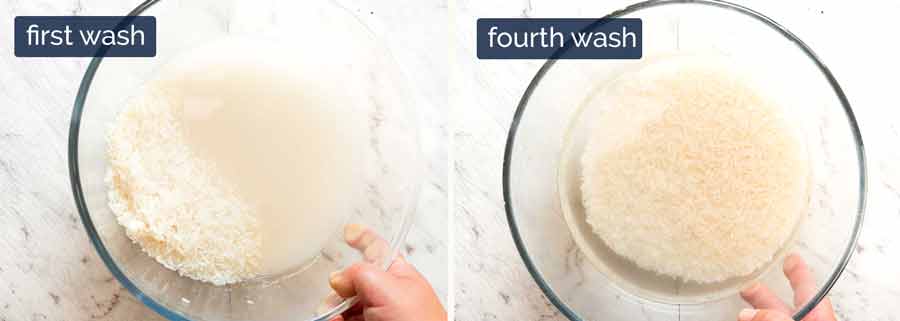
JUMP TO Video | Recipe
Troubleshooting!
-
Scorched base – when you fluff the rice, you discover the base of the pot is burnt.
-
Heat was too high – some stoves are more powerful than others, and might be too powerful for the saucepan size you are using. Move to a smaller burner.
-
Pot is too large – don't use a large pot for a small amount of rice. This causes the liquid to evaporate too quickly inside the pot, which will result in the rice being scorched.
-
-
Water not absorbed – don't take the rice off the stove until the liquid is fully absorbed (tilt saucepan to check). 13 minutes is the average time for an average stove, but if yours is weaker, it might take 15 to 17 minutes. In addition, don't skipresting the rice for 10 minutes after cooking. During this stage, any residual water will be absorbed!
-
Rice not properly cooked – unevenly cooked rice grains, with some still hard
-
Did you peek while the rice was cooking? That will allow steam to escape which stops the rice from cooking properly!
-
Did you rest the rice for 10 minutes? This is when the rice finishes cooking.
-
Did you use an appropriate size pot? Don't use a giant cauldron to cook 1 cup of rice! That will make the liquid evaporate too fast.
-
Fix it! Add an extra 1/4 cup water for every 1 cup rice you used, then put it back on the stove with the lid on for 5 minutes on low, then rest 10 minutes.
-
-
Rice too hard for your taste – my recipe makes rice al dente, the Asian way, like it's served at your favourite Chinese, Thai, Japanese and other Asian restaurants. It may be a touch firm for some people who grew up on softer rice. Use my base recipe as your starting point, then add an extra 2 tbsp water for your next batch and see if it's soft enough for your taste. For each batch after that, add an extra 1 tbsp water until it's the right texture for you.
-
Overflow messon the stove or microwave – the saucepan should be about 4 to 5 times the water level and should have a heavy lid. For microwave rice, ensure the container is at least 4 times the height of the water level.Oven baked rice doesn't have overflow problems because it cooks more slowly.
-
Cooking rice at high altitude – for stove, add 1 minute extra cook time for every 300m/1,000ft above sea level. This is the rule of thumb for boiling things at high altitude – because the boiling point of water is lower so things take longer to cook.
TIPS
-
NO PEEKING, NO STIRRING! Do not lift the lid or stir the rice while it's cooking. That's the surefire way to ruin it! Lifting the lid releases the steam = undercooked / unevenly cooked rice. Stirring = activates starch = gluey rice (this is the worst!).
-
NEVER skip resting for 10 minutes – this is when the rice finishes cooking in the residual heat and the water on the surface of each grain is fully absorbed, leaving you with perfectly fluffy, never gluey rice.
-
Don't bring to heavy BOIL – for stovetop rice, don't bring it to a rapid boil because then it's so hot, when you put the lid on it will trap in so much heat it will probably boil over. Just bring it to a simmer/gentle boil on medium high (see video!) so there's big gentle bubbles on the surface and it gets a bit foamy. You may still get a bit of liquid boil over if your lid isn't heavy enough – if this happens, just add 1 tablespoon extra water next time!
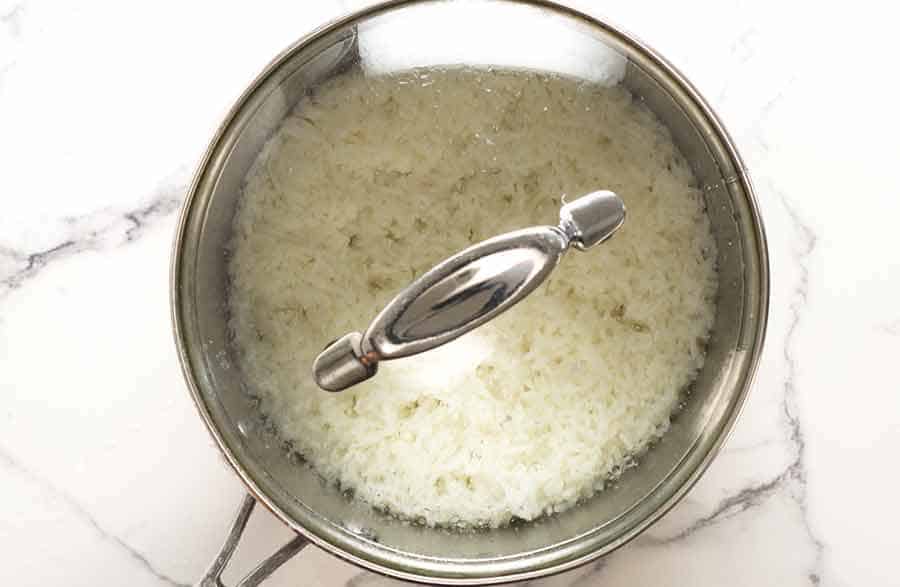
JUMP TO Video | Recipe
USEFUL TO KNOW
-
Rice to water ratio –1 cup of rice to 1.5 cups of water for rice cooked on the stove. Increase to 2 cups of water per 1 cup of rice for oven and microwave.
-
How long does rice last in the fridge? 4 days in an airtight container. Some say it will go to 6 days, but I prefer to err on the side of caution.
-
Freezing rice – rice freezes extremely well! It will keep for 3 to 4 months in the freezer.
-
How to reheat rice – the best way is to place rice in a bowl, drizzle with 2 teaspoons water per 1 cup of cold rice, cover with cling wrap then microwave on high for 1 minute. The water will create a steamy environment and make the rice moist and fresh again.
-
Can you eat cold rice?Yes you can. But it's not very pleasant – it's hard and dry. Cold rice is perfect (and necessary!) for Fried Rice! Or use for Chinese Rice Soup (just add towards the end at the point where the rice would be cooked in the recipe.)
-
How much rice does 1 cup uncooked rice make? 1 cup uncooked rice = 3 cups (packed) cooked rice. It is enough for 3 normal servings, or 4 smaller servings.
-
Don't have to use measuring cups– you can useanything to measure the rice and water as long as you use the same ratio. For example, 1 level mug of rice and 1 1/2 mugs of water. Or use a bowl or can or jug – anything!
-
Calories in rice –1 cup cooked white rice has 206 calories.
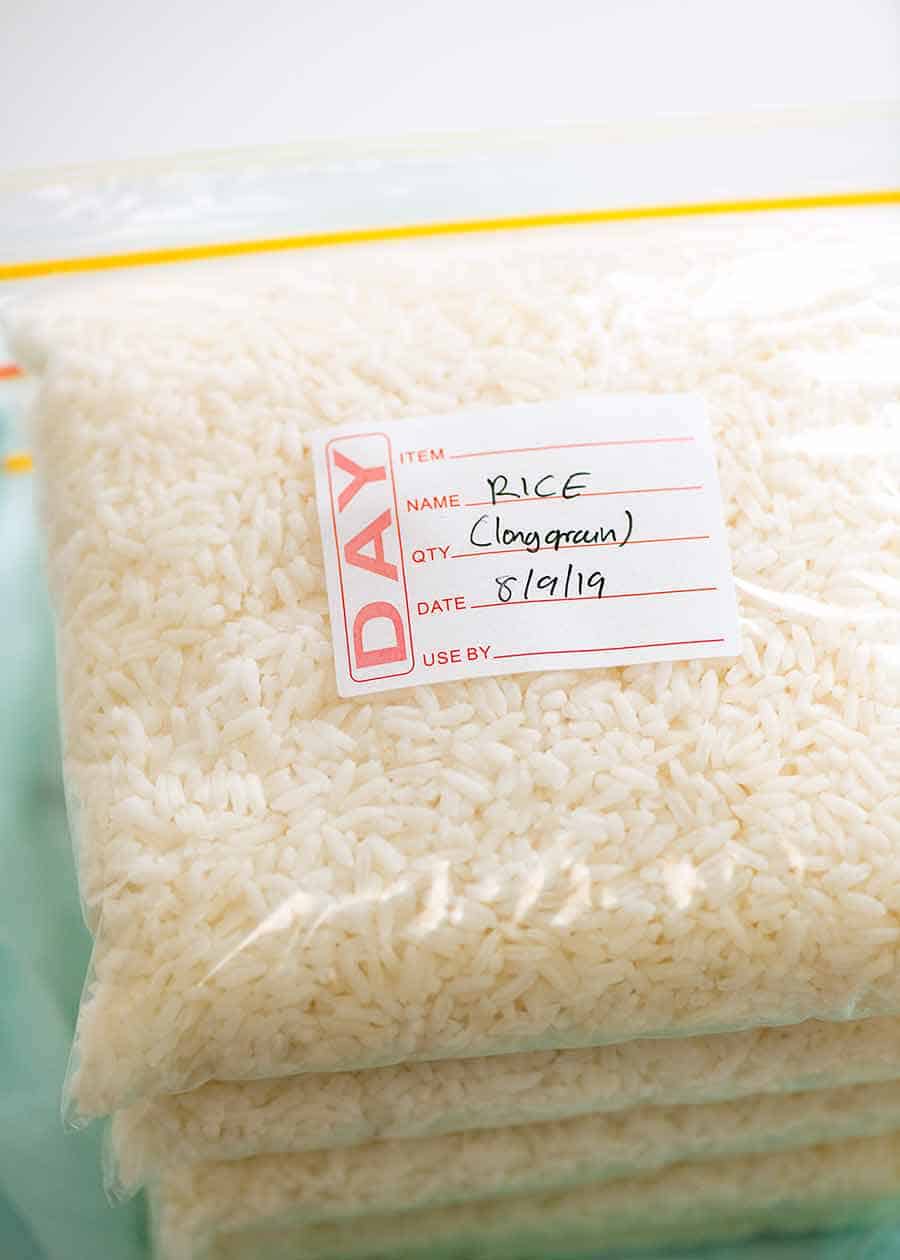
What to serve with rice
Ah, the fun part!! Here's just a few suggestions:
-
Stir fries – stir fries weremade to soak rice with the tasty sauces!
-
Curries – curry sauces and rice are best mates, right??
-
Make Chinese fried rice! Or Nasi Goreng (Indo Fried Rice) or Thai Fried Rice. Or Kimchi Fried Rice!
-
With your favourite Chilli Con Carne (try this Shredded Beef version!)
-
Serve with other saucy things like Beef Stroganoff, Honey Mustard Chicken
-
Make a rice salad
-
Make Bibimbap – Korean Rice Bowl!
To be honest, I think that rice goes well with anything that's saucey – Asian or not Asian. Because rice is a neutral flavour, it works well with anything!
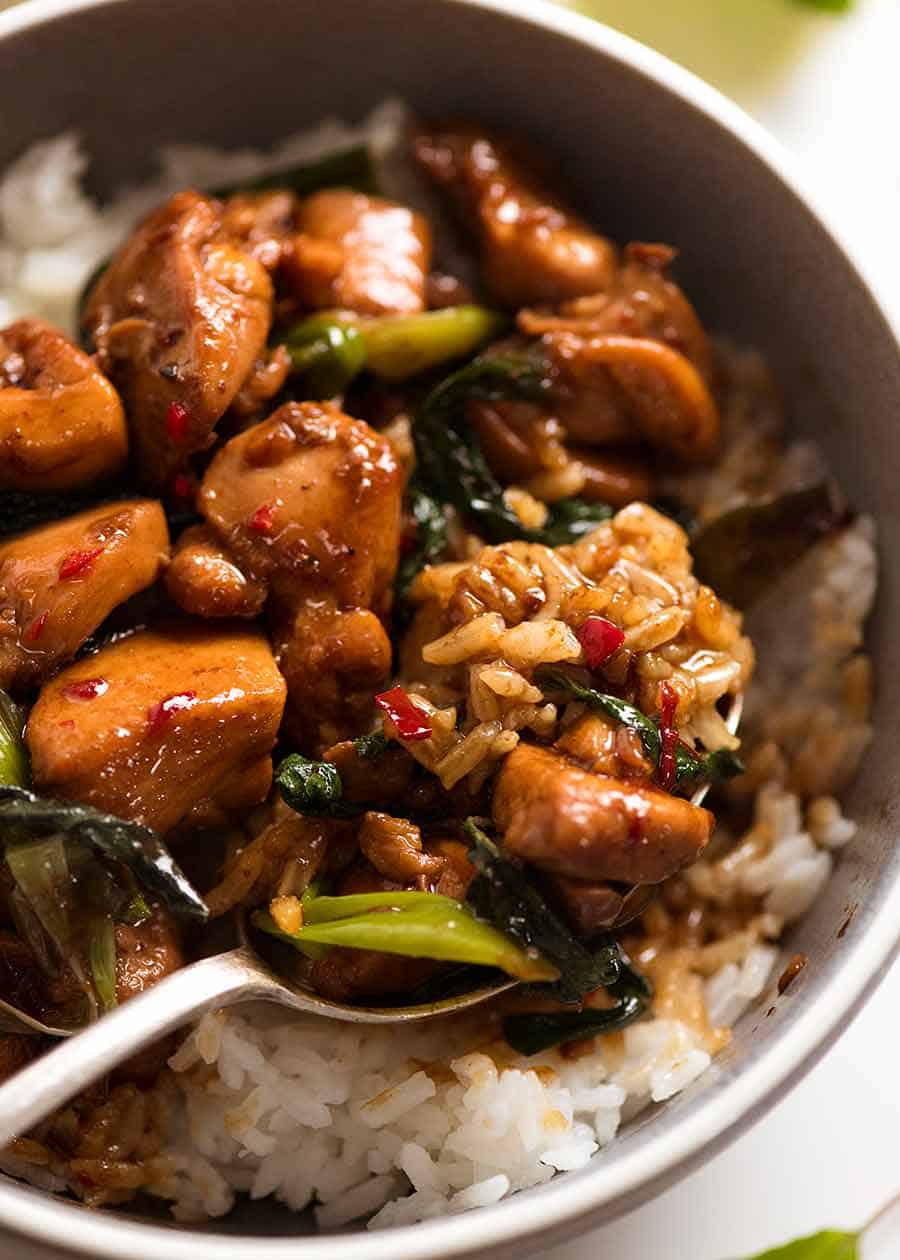
Congratulations – you're now a Rice Master!
If you've made it this far, you're now armed with the basics for how to cook rice perfectly! You'll be able to make rice anytime, anywhere, without any special equipment.
A world of deliciousness awaits you – think of all the things you're going to be on your rice, and cookwith your rice! – Nagi x
Watch how to make it
Subscribe to my newsletter and follow along on Facebook, Pinterest and Instagram for all of the latest updates.
Servings 3 cups cooked rice
Tap or hover to scale
Recipe video above. Use this recipe for short, medium and long grain white rice. See separate recipes for: jasmine, basmati and brown rice.
Stovetop is the most versatile method and yields the best result for perfect, evenly cooked fluffy rice. This is my default, favourite method. The oven is the next best (min 2 cups rice recommended) – handy for big batch, hands off cooking, but it takes the longest. The microwave method is extremely handy to know because it's hands off AND fast, and it's the method I use when I'm pressed for time – or on hectic shoot days!
Stovetop (my default method):
- 1 cup white rice – short, medium or long grain, uncooked (Note 1)
- 1 1/2 cups water
Oven:
- 2 cups white rice – short, medium or long grain (Note 1, 2)
- 3 cups boiling water (Note 3)
Microwave:
- 1 cup white rice – short, medium or long grain (Note 1)
- 2 cups boiling water (Note 3)
Check rice type:
-
This recipe is for the following white rice types: long grain, medium grain, short grain (excluding sushi rice). See separate recipes for: basmati, jasmin and brown rice.
Stovetop (my default):
-
Place water and rice in a large saucepan over medium high heat.
-
Once the entire surface of the water is bubbling gently(and it gets a bit foamy, see video), turn heat down to low and cover with lid.
-
Leave for 13 minutes – do not stir, do not remove lid. Water should now all be absorbed – tilt to check.
-
Remove from stove, still with lid, and leave for 10 minutes.
-
Remove lid, fluff with rice paddle or fork, and serve!
Oven:
-
Preheat oven to 200°C/390°F (180°C fan forced).
-
Use a small casserole pot about 24cm/10" wide with a lid. (Note 4)
-
Place boiling water and rice in pot, cover with lid and bake for 35 minutes.
-
Remove from oven, and leave for 10 minutes with the lid still on.
-
Remove lid, fluff with rice paddle or fork, and serve! (Makes 6 cups)
Microwave:
-
Place rice and boiling water in tall microwave proof container (Note 5).
-
Microwave on high for 12 minutes with NO LID (1100 – 1200W microwaves).
-
Remove, cover with lid, leave for 10 minutes.
-
Remove lid, fluff with rice paddle or fork, and serve!
1. Rice types – u se this rice recipe for:
- long grain white rice
- medium grain white rice
- short grain white riceexcept sushi rice
- basmati rice
- jasmine rice
DO NOT use this recipe for:
- brown rice (coming soon)
- sushi rice – use the directions in this recipe
- wild rice (cook per this recipe), black rice, or other special rices
- risotto rice – use a risotto recipe
- paella rice – use this Paella recipe
- quinoa – follow this recipe
2. More rice for oven – rice cooked in the oven is prone to crispy edges if you cook a small quantity. The minimum I recommend cooking in the oven is 2 cups.
3. Boiling water for oven and microwave – allows rice to cook more evenly (water takes longer to come to temperature in oven, and in microwave, they generally cook from outside in which leads to uneven cooking of rice).
4. Oven baking vessel – medium size 24cm/10″ ceramic or cast iron pot with lid is ideal. Otherwise, use a 20cm/8″ pan and foil. If you scale up, use a larger pan.
5. Microwave container – you need a tall microwave proof container, preferably round (cooks more evenly), that's 3 to 4 times the height of the water level with the rice in (water bubbles up).
May need to increase cook time if your microwave is not as strong.
6. QUANTITY of cooked rice: 1 cup of uncooked rice = 3 cups (packed) of cooked rice.
7. STORING –fridge for 4 days in an airtight container, freezer for 3 months. Once refrigerated, rice becomes dry, making it perfect for using in fried rice.
To reheat for serving (eg for stir fries or curries), sprinkle with 2 tsp water per 1 cup cooked rice, cover with lid or cling wrap and microwave – water will make moist again.
8. Cooking rice at HIGH ALTITUDE:Add 1 minute stove cook time for every 300m/1,000ft above sea level (because boiling point of water is lower = longer cook time). Depending on how heavy weight your pot is, you may find you need to add 1 – 2 tbsp extra water (to compensate for loss of liquid via steam due to longer cook time), but tweak that in subsequent batches.
9. Nutrition per 1 cup cooked rice.
Calories: 205 cal (10%) Carbohydrates: 45 g (15%) Protein: 4 g (8%) Fat: 1 g (2%) Saturated Fat: 1 g (6%) Sodium: 2 mg Potassium: 55 mg (2%) Fiber: 1 g (4%) Sugar: 1 g (1%) Calcium: 16 mg (2%) Iron: 1 mg (6%)
Keywords: how to cook rice, how to cook rice on the stove, ratio of rice to water, steamed white rice
Life of Dozer
His current favourite toy. It's so appropriate 😈
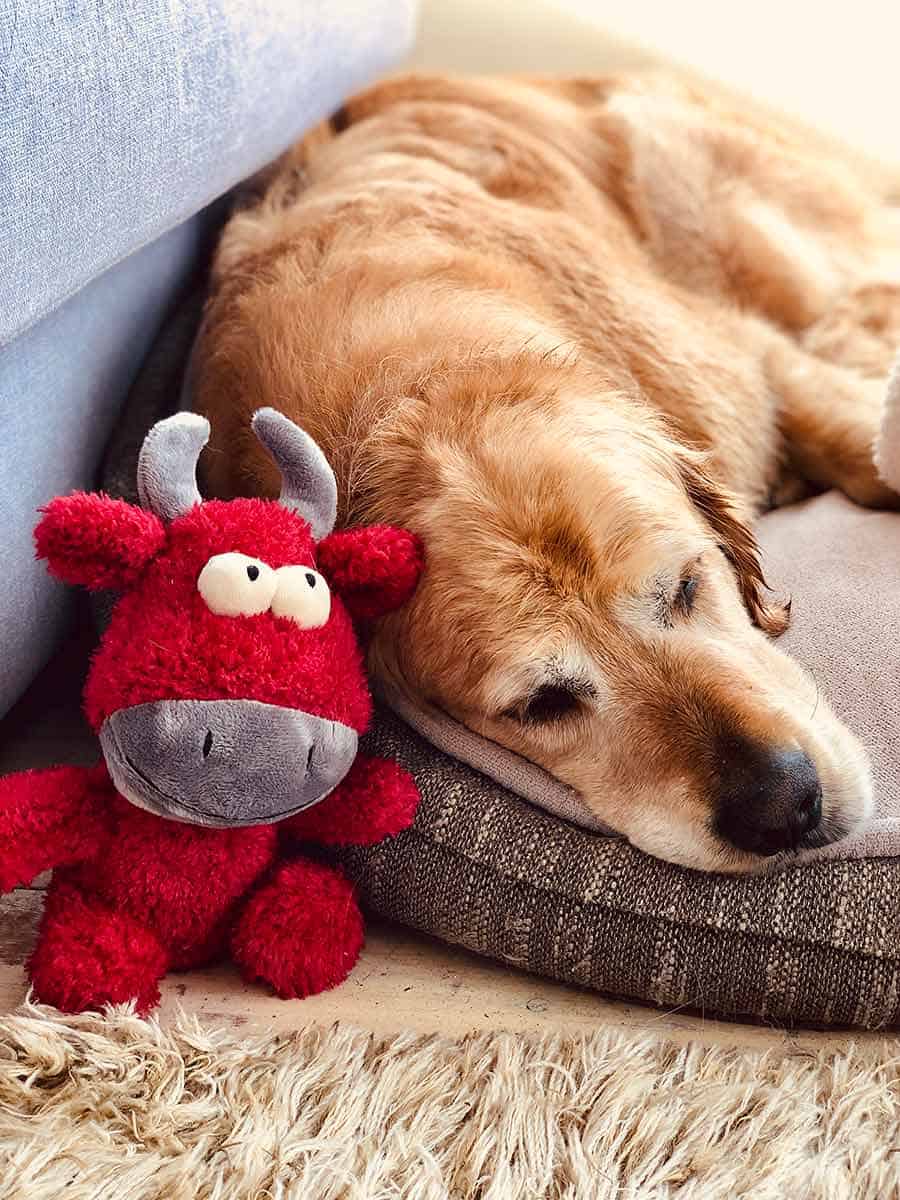
Does Rice Paper Cake Sheet Have a Backing to Remove
Source: https://www.recipetineats.com/how-to-cook-rice/
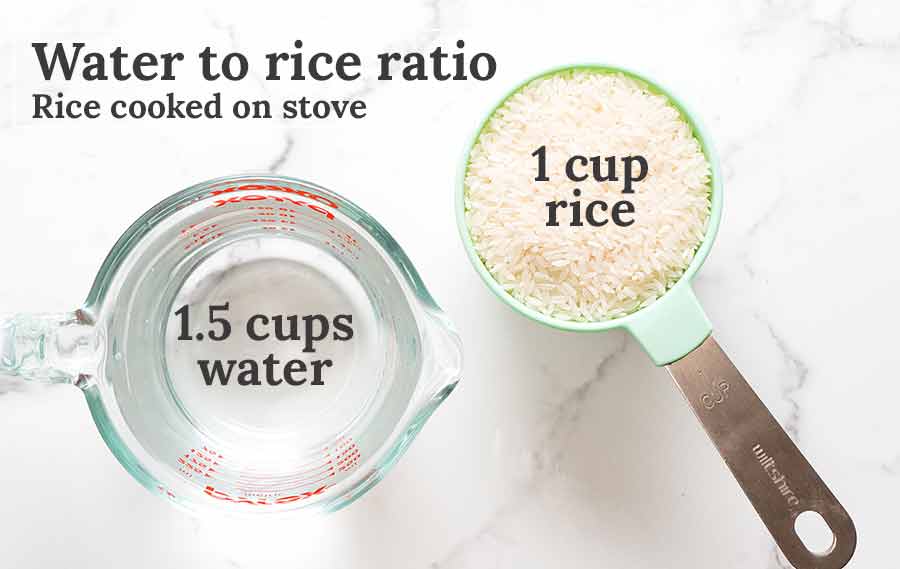
0 Response to "Does Rice Paper Cake Sheet Have a Backing to Remove"
إرسال تعليق